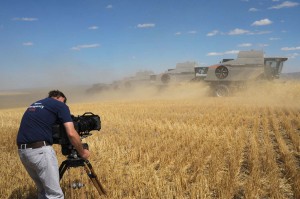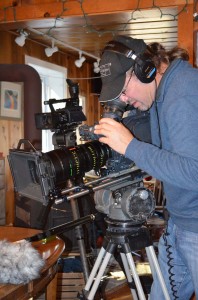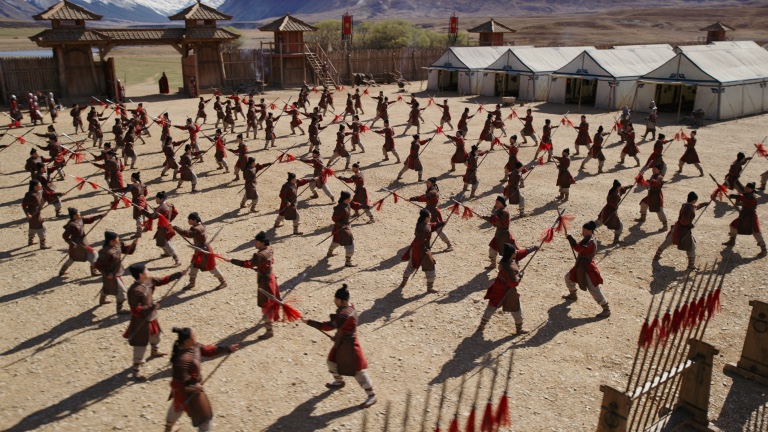![]()

Harvesting the High Plains recounts the hardships and challenges faced by farmers during the 1930s Dust Bowl – a time when farmland was devastated by extreme drought and excessive farming. The 90-minute film tells the true story of two farmers – Ray Garvey of Wichita, Kansas and John Kriss of Colby, Kansas – who are credited with the expanded use of the innovative Summer Fallow agricultural method as well as other innovative farming methods that transformed uncultivated prairies into high yielding fields of wheat while conserving and respecting the land they used. The film depicts the fortitude of the American spirit that brought the country out of the Great Depression. “Something we all need to be reminded of in this present time,” said Kriss.
Kriss began shooting the documentary in the summer of 2010 using a Panasonic AJ-HP3700 P2 HD VariCam camcorder outfitted with a Fujinon HAe10x10 (10x100mm) E-Series HD zoom lens. In early 2011, he added a complement of Fujinon E-Series HD prime lenses, including the HAeF5 5mm; HAeF8 8mm; HAeF10 10mm; HAeF12 12mm; HAeF16 16mm; HAeF20 20mm; HAeF34 34mm; and HAeF54 54mm, which enabled him to match the needs of each shot with the ideal lens.
“The Fujinon digital cinema lenses gave me creative latitude that exceeded anything I’ve experienced with other brand lenses,” said Kriss. “This film greatly benefits from the depth of field, precision, and clarity these lenses produce.”
“We really put these lenses to the test by shooting for weeks under extreme production conditions,” Kriss added. Besides temperatures exceeding 102 degrees, the lenses were continually subjected to extremely hot, dry, dusty winds common to the plains of Western Nebraska and Western Kansas. Every evening, Kriss would spend 1.5-2 hours meticulously cleaning dust from the lenses, but they never failed to perform.
“We also pushed these lenses creatively,” Kriss said. “We adjusted the camera’s menus to shoot monochromatically, and then affixed a ‘Red 25’ filter to the lens to obtain a high-contrast effect. Since the filter costs 4.5 stops, it was extremely advantageous to be able to open the lenses as far as possible, from T2.2 to T1.6, to maximize available light.” This also allowed Kriss to shoot with a very open lens – a style he prefers.
The finished film pulls together black-and-white establishing shots, historical footage, interview segments shot in color, and a black-and-white scene featuring actors in 1930s’ period dress operating vintage farm equipment to harvest a field of wheat. Currently in post, Harvesting the High Plains will be color graded to adjust and match the contrast and color temperatures of all scenes prior to 35mm mastering.
 DP Kriss and producer Sydney Duvall co-wrote the script, which was based upon tens of thousands of letters exchanged by Ray Garvey and John Kriss. The letters, sent daily via the U.S. Postal Service, documented the history of their massive farm operation, GK Farms, as well as the national challenges caused by such historical events as The Great Depression, The Dust Bowl and World War II.
DP Kriss and producer Sydney Duvall co-wrote the script, which was based upon tens of thousands of letters exchanged by Ray Garvey and John Kriss. The letters, sent daily via the U.S. Postal Service, documented the history of their massive farm operation, GK Farms, as well as the national challenges caused by such historical events as The Great Depression, The Dust Bowl and World War II.
According to Duvall, “This film documents the strength and resilience of these two farmers as they persevered to build an agricultural enterprise that eventually produced an unprecedented one million bushels of wheat by 1947 – an accomplishment we hope will inspire contemporary Americans, many of whom are also facing tough economic times.”
Inspirit Creative, (co-owned by Kriss and Duvall) has also partnered with Back 40 Films for the feature documentary production, The Vanishing Hemlock. The documentary focuses on the mass-scale death of more than 75 percent of the hemlock trees throughout the Smoky Mountains, and one man’s commitment to save what’s left. At times Kriss climbed more than 100 feet into a tree to shoot, and also captured extensive aerial footage with his Fujinon lens. Produced by David Huff and Back 40 Films in association with Inspirit Creative, The Vanishing Hemlock will be released on Arbor Day in 2012.






